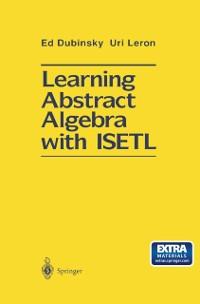
ISBN: 9781461226024
*Learning Abstract Algebra with ISETL* - Auflage 1994 / pdf eBook für 53.49 € / Aus dem Bereich: eBooks, Fachthemen & Wissenschaft, Mathematik Medien > Bücher nein eBook als pdf eBooks > … Mehr…
| Hugendubel.de Versandkosten:In stock (Download), , Versandkostenfrei nach Hause oder Express-Lieferung in Ihre Buchhandlung., DE. (EUR 0.00) Details... |

ISBN: 9781461226024
*Learning Abstract Algebra with ISETL* / pdf eBook für 53.49 € / Aus dem Bereich: eBooks, Fachthemen & Wissenschaft, Mathematik Medien > Bücher nein eBook als pdf eBooks > Fachthemen & Wi… Mehr…
| Hugendubel.de Versandkosten:In stock (Download), , Versandkostenfrei nach Hause oder Express-Lieferung in Ihre Buchhandlung., DE. (EUR 0.00) Details... |

ISBN: 9781461226024
Learning Abstract Algebra with ISETL - Auflage 1994: ab 53.49 € eBooks > Fachthemen & Wissenschaft > Mathematik Springer New York eBook als pdf, Springer New York
| eBook.de Versandkosten:in stock, , , DE. (EUR 0.00) Details... |

ISBN: 9781461226024
Learning Abstract Algebra with ISETL: ab 53.49 € eBooks > Fachthemen & Wissenschaft > Mathematik Springer New York eBook als pdf, Springer New York
| eBook.de Versandkosten:in stock, , , DE. (EUR 0.00) Details... |

2013, ISBN: 9781461226024
eBooks, eBook Download (PDF), [PU: Springer New York], Springer New York, 2013
| lehmanns.de Versandkosten:Download sofort lieferbar. (EUR 0.00) Details... |


ISBN: 9781461226024
*Learning Abstract Algebra with ISETL* - Auflage 1994 / pdf eBook für 53.49 € / Aus dem Bereich: eBooks, Fachthemen & Wissenschaft, Mathematik Medien > Bücher nein eBook als pdf eBooks > … Mehr…

ISBN: 9781461226024
*Learning Abstract Algebra with ISETL* / pdf eBook für 53.49 € / Aus dem Bereich: eBooks, Fachthemen & Wissenschaft, Mathematik Medien > Bücher nein eBook als pdf eBooks > Fachthemen & Wi… Mehr…

ISBN: 9781461226024
Learning Abstract Algebra with ISETL - Auflage 1994: ab 53.49 € eBooks > Fachthemen & Wissenschaft > Mathematik Springer New York eBook als pdf, Springer New York

ISBN: 9781461226024
Learning Abstract Algebra with ISETL: ab 53.49 € eBooks > Fachthemen & Wissenschaft > Mathematik Springer New York eBook als pdf, Springer New York

2013, ISBN: 9781461226024
eBooks, eBook Download (PDF), [PU: Springer New York], Springer New York, 2013
Bibliographische Daten des bestpassenden Buches
| Autor: | |
| Titel: | |
| ISBN-Nummer: |
Detailangaben zum Buch - Learning Abstract Algebra with ISETL
EAN (ISBN-13): 9781461226024
Erscheinungsjahr: 2013
Herausgeber: Springer New York
Buch in der Datenbank seit 2016-03-18T08:57:15+01:00 (Berlin)
Detailseite zuletzt geändert am 2024-02-14T15:22:59+01:00 (Berlin)
ISBN/EAN: 9781461226024
ISBN - alternative Schreibweisen:
978-1-4612-2602-4
Alternative Schreibweisen und verwandte Suchbegriffe:
Autor des Buches: dubin, dubinsky
Titel des Buches: abstract algebra
Daten vom Verlag:
Autor/in: Ed Dubinsky; Uri Leron
Titel: Learning Abstract Algebra with ISETL
Verlag: Springer; Springer US
248 Seiten
Erscheinungsjahr: 2013-12-01
New York; NY; US
Sprache: Englisch
53,49 € (DE)
55,00 € (AT)
59,00 CHF (CH)
Available
XXI, 248 p.
EA; E107; eBook; Nonbooks, PBS / Mathematik/Arithmetik, Algebra; Gruppen und Gruppentheorie; Verstehen; Abstract algebra; algebra; homomorphism; matrices; Permutation; polynomial; ring; ring homomorphism; B; Group Theory and Generalizations; Group Theory and Generalizations; Mathematics and Statistics; BB
1 Mathematical Constructions in ISETL.- 1.1 Using ISETL.- 1.1.1 Activities.- 1.1.2 Getting started.- 1.1.3 Simple objects and operations on them.- 1.1.4 Control statements.- 1.1.5 Exercises.- 1.2 Compound objects and operations on them.- 1.2.1 Activities.- 1.2.2 Tuples.- 1.2.3 Sets.- 1.2.4 Set and tuple formers.- 1.2.5 Set operations.- 1.2.6 Permutations.- 1.2.7 Quantification.- 1.2.8 Miscellaneous ISETL features.- 1.2.9 VISETL.- 1.2.10 Exercises.- 1.3 Functions in ISETL.- 1.3.1 Activities.- 1.3.2 Funcs.- 1.3.3 Alternative syntax for funcs.- 1.3.4 Using furies to represent situations.- 1.3.5 Furies for binary operations.- 1.3.6 Fumes to test properties.- 1.3.7 Smaps.- 1.3.8 Procs.- 1.3.9 Exercises.- 2 Groups.- 2.1 Getting acquainted with groups.- 2.1.1 Activities.- 2.1.2 Definition of a group.- 2.1.3 Examples of groups.- Number systems.- Integers mod n.- Symmetric groups.- Symmetries of the square.- Groups of matrices.- 2.1.4 Elementary properties of groups.- 2.1.5 Exercises.- 2.2 The modular groups and the symmetric groups.- 2.2.1 Activities.- 2.2.2 The modular groups Zn.- 2.2.3 The symmetric groups Sn.- Orbits and cycles.- 2.2.4 Exercises.- 2.3 Properties of groups.- 2.3.1 Activities.- 2.3.2 The specific and the general.- 2.3.3 The cancellation law—An illustration of the abstract method.- 2.3.4 How many groups are there?.- Classifying groups of order 4.- 2.3.5 Looking ahead—subgroups.- 2.3.6 Summary of examples and non-examples of groups.- 2.3.7 Exercises.- 3 Subgroups.- 3.1 Definitions and examples.- 3.1.1 Activities.- 3.1.2 Subsets of a group.- Definition of a subgroup.- 3.1.3 Examples of subgroups.- Embedding one group in another.- Conjugates.- Cycle decomposition and conjugates in Sn.- 3.1.4 Exercises.- 3.2 Cyclic groups and their subgroups.- 3.2.1 Activities.- 3.2.2 The subgroup generated by a single element.- 3.2.3 Cyclic groups.- The idea of the proof.- 3.2.4 Generators.- Generators of Sn.- Parity—even and odd permutations.- Determining the parity of a permutation.- 3.2.5 Exercises.- 3.3 Lagrange’s theorem.- 3.3.1 Activities.- 3.3.2 What Lagrange’s theorem is all about.- 3.3.3 Cosets.- 3.3.4 The proof of Lagrange’s theorem.- 3.3.5 Exercises.- 4 The Fundamental Homomorphism Theorem.- 4.1 Quotient groups.- 4.1.1 Activities.- 4.1.2 Normal subgroups.- Multiplying cosets by representatives.- 4.1.3 The quotient group.- 4.1.4 Exercises.- 4.2 Homomorphisms.- 4.2.1 Activities.- 4.2.2 Homomorphisms and kernels.- 4.2.3 Examples.- 4.2.4 Invariants.- 4.2.5 Homomorphisms and normal subgroups.- An interesting example.- 4.2.6 Isomorphisms.- 4.2.7 Identifications.- 4.2.8 Exercises.- 4.3 The homomorphism theorem.- 4.3.1 Activities.- 4.3.2 The canonical homomorphism.- 4.3.3 The fundamental homomorphism theorem.- 4.3.4 Exercises.- 5 Rings.- 5.1 Rings.- 5.1.1 Activities.- 5.1.2 Definition of a ring.- 5.1.3 Examples of rings.- 5.1.4 Rings with additional properties.- Integral domains.- Fields.- 5.1.5 Constructing new rings from old—matrices.- 5.1.6 Constructing new rings from old—polynomials.- 5.1.7 Constructing new rings from old—functions.- 5.1.8 Elementary properties—arithmetic.- 5.1.9 Exercises.- 5.2 Ideals.- 5.2.1 Activities.- 5.2.2 Analogies between groups and rings.- 5.2.3 Subrings.- Definition of subring.- 5.2.4 Examples of subrings.- Subrings of Zn and Z.- Subrings of ?(R).- Subrings of polynomial rings.- Subrings of rings of functions.- 5.2.5 Ideals and quotient rings.- Definition of ideal.- Examples of ideals.- 5.2.6 Elementary properties of ideals.- 5.2.7 Elementary properties of quotient rings.- Quotient rings that are integral domains—prime ideals.- Quotient rings that are fields—maximal ideals.- 5.2.8 Exercises.- 5.3 Homomorphisms and isomorphisms.- 5.3.1 Activities.- 5.3.2 Definition of homomorphism and isomorphism.- Group homomorphisms vs. ring homomorphisms.- 5.3.3 Examples of homomorphisms and isomorphisms.- Homomorphisms from Zn to Zk.- Homomorphisms of Z.- Homomorphisms of polynomial rings.- Embeddings—Z, Zn as universal subobjects.- The characteristic of an integral domain and a field.- 5.3.4 Properties of homorphisms.- Preservation.- Ideals and kernels of ring homomorphisms.- 5.3.5 The fundamental homomorphism theorem.- The canonical homomorphism.- The fundamental theorem.- Homomorphic images of Z, Zn.- Identification of quotient rings.- 5.3.6 Exercises.- 6 Factorization in Integral Domains.- 6.1 Divisibility properties of integers and polynomials.- 6.1.1 Activities.- 6.1.2 The integral domains Z, Q[x].- Arithmetic and factoring.- The meaning of unique factorization.- 6.1.3 Arithmetic of polynomials.- Long division of polynomials.- 6.1.4 Division with remainder.- 6.1.5 Greatest Common Divisors and the Euclidean algorithm.- 6.1.6 Exercises.- 6.2 Euclidean domains and unique factorization.- 6.2.1 Activities.- 6.2.2 Gaussian integers.- 6.2.3 Can unique factorization fail?.- 6.2.4 Elementary properties of integral domains.- 6.2.5 Euclidean domains.- Examples of Euclidean domains.- 6.2.6 Unique factorization in Euclidean domains.- 6.2.7 Exercises.- 6.3 The ring of polynomials over a field.- 6.3.1 Unique factorization in F[x].- 6.3.2 Roots of polynomials.- 6.3.3 The evaluation homomorphism.- 6.3.4 Reducible and irreducible polynomials.- Examples.- 6.3.5 Extension fields.- Construction of the complex numbers.- 6.3.6 Splitting fields.- 6.3.7 Exercises.This book is based on the constructivist belief that, before students can make sense of any presentation of abstract mathematics, they need to be engaged in mental activities which will establish an experiential base for any future verbal explanation. The main source of activities in this course is computer constructions, specifically, small programs written in the mathlike programming language ISETL; the main tool for reflections is work in teams of 2-4 students, where the activities are discussed and debated.
Weitere, andere Bücher, die diesem Buch sehr ähnlich sein könnten:
Neuestes ähnliches Buch:
9781461276029 Learning Abstract Algebra with ISETL Ed Dubinsky Author (Uri Leron)
- 9781461276029 Learning Abstract Algebra with ISETL Ed Dubinsky Author (Uri Leron)
- 9781461276104 Learning Abstract Algebra with ISETL by Ed Dubinsky Paperback | Indigo Chapters (Ed Dubinsky; Uri Leron)
- 9780387941042 Learning Abstract Algebra with ISETL (Mathematical Systems; 403) (Dubinsky, Ed, Leron, Uri)
- Learning Abstract Algebra with ISETL. (Dubinsky, E.; U. Leron)
< zum Archiv...



